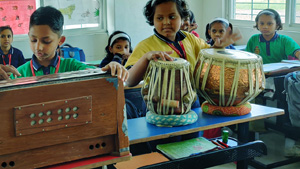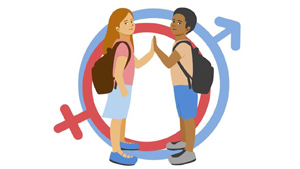In today’s ever-evolving educational landscape, academics alone are no longer sufficient to develop a well-rounded individual. That’s where co-curricular activities come into play. In a nutshell, co-curricular activities encompass all the educational, cultural, social, and recreational activities that take place alongside the academic curriculum.
These activities provide students with opportunities to explore their interests, develop new skills, and foster a sense of teamwork and collaboration. From participating in sports teams and clubs to engaging in community service, students can discover their passions and learn important life skills outside the classroom.

Image by preprimaryschools.com
Research has shown that students who actively participate in co-curricular activities tend to have higher academic achievements, improved social interactions, enhanced critical thinking abilities, and increased self-confidence. By engaging in these activities, students are able to apply what they have learned in the classroom to real-life situations and develop a well-rounded personality.
Definition of co-curricular activities
Co-curricular activities refer to the wide range of activities that students can engage in alongside their academic studies. These activities are designed to complement and enhance the overall educational experience. Unlike extracurricular activities, which are often optional and take place outside of regular school hours, co-curricular activities are integrated into the school curriculum and are mandatory or strongly encouraged for students to participate in.
Co-curricular activities can take many forms, including sports teams, clubs, student government, community service projects, performing arts groups, academic competitions, and more. These activities provide students with opportunities to explore their interests, develop new skills, and broaden their horizons beyond the confines of the classroom.
Importance of co-curricular activities in education
Co-curricular activities play a crucial role in the holistic development of students. While academics provide students with knowledge and skills in specific subjects, co-curricular activities offer a platform for students to apply and further develop these skills in real-world contexts.
One of the key benefits of co-curricular activities is the opportunity for students to discover and explore their passions and interests. These activities expose students to a wide range of fields and disciplines, allowing them to develop a sense of what they enjoy and excel at. This can help students make more informed decisions about their future career paths and areas of study.
Participating in co-curricular activities also fosters important life skills such as teamwork, leadership, time management, and communication. Through collaborative projects, students learn how to work effectively in teams, delegate tasks, and solve problems collectively. These skills are highly valued by employers and are essential for success in the professional world.
Co-curricular activities provide a platform for students to develop their social skills and build meaningful relationships with their peers. By engaging in shared interests and common goals, students develop a sense of belonging and camaraderie. This can greatly enhance their overall educational experience and contribute to their personal growth and well-being.
Types of co-curricular activities
Co-curricular activities encompass a wide range of options to cater to the diverse interests and talents of students. Here are some common types of co-curricular activities found in educational institutions:
Sports Teams
Participating in sports teams helps students develop physical fitness, discipline, teamwork, and resilience. It also promotes a healthy competitive spirit and teaches valuable lessons about sportsmanship.
Clubs and Organizations
Clubs provide students with a platform to pursue their interests and hobbies. Whether it’s a debate club, a photography club, or a coding club, these organizations allow students to delve deeper into their passions and connect with like-minded individuals.
Performing Arts Groups
Drama clubs, music ensembles, and dance troupes offer opportunities for students to explore their creative talents and express themselves through various art forms. These activities promote self-expression, confidence, and stage presence.
Community Service Projects
Engaging in community service projects allows students to make a positive impact in their local communities. Whether it’s volunteering at a soup kitchen, organizing a charity event, or participating in environmental initiatives, these activities instill a sense of empathy, compassion, and social responsibility in students.
Academic Competitions
Academic competitions such as science fairs, math Olympiads, and debate tournaments provide students with opportunities to showcase their knowledge and critical thinking abilities. These competitions promote intellectual curiosity, research skills, and problem-solving abilities.
Leadership Roles
Student government and leadership positions within clubs and organizations offer students the chance to develop their leadership skills and take on responsibilities. These roles teach students how to effectively communicate, make decisions, and manage teams.
Benefits of participating in co-curricular activities
The benefits of participating in co-curricular activities extend far beyond the immediate enjoyment of the activities themselves. Here are some key advantages that students gain from engaging in these activities:
Enhanced Academic Performance
Research has consistently shown that students who participate in co-curricular activities tend to have higher academic achievements. This is because these activities teach valuable skills such as time management, discipline, and focus, which can be applied to academic studies.
Improved Social Skills
Co-curricular activities provide students with opportunities to interact with their peers and develop social skills. By collaborating with others, students learn how to communicate effectively, resolve conflicts, and build relationships, all of which are crucial for success in both personal and professional settings.
Increased Self-Confidence
Participating in co-curricular activities helps students build self-confidence as they master new skills and overcome challenges. The sense of achievement and recognition gained from these activities boosts students’ self-esteem and belief in their abilities.
Holistic Development
Co-curricular activities contribute to the holistic development of students by nurturing their physical, intellectual, emotional, and social well-being. These activities encourage students to explore their passions, develop a sense of identity, and become well-rounded individuals.
Career Advancement
Co-curricular activities provide students with valuable experiences and skills that can set them apart in the job market. Employers often look for candidates who have demonstrated leadership, teamwork, and a willingness to go beyond their academic responsibilities.
How co-curricular activities enhance learning?
Co-curricular activities enhance learning by providing students with practical applications of classroom knowledge and fostering the development of essential skills. Here’s how these activities contribute to the learning process:
Application of Knowledge
Co-curricular activities allow students to apply what they have learned in the classroom to real-life situations. For example, a biology club may conduct experiments, a journalism club may publish a school newspaper, or a robotics team may build a working robot. This hands-on experience deepens students’ understanding of concepts and helps them see the relevance of their studies.
Critical Thinking and Problem-Solving
Co-curricular activities often require students to think critically and solve problems. Whether it’s developing strategies for a chess tournament, troubleshooting technical issues during a theater production, or solving complex equations in a math competition, these activities challenge students to think creatively and analytically.
Collaboration and Teamwork
Many co-curricular activities involve working in teams or groups. This collaboration fosters teamwork, communication, and cooperation among students. They learn to value different perspectives, delegate tasks, and work towards a common goal. These skills are essential for success in the professional world where teamwork is often necessary.
Time Management and Prioritization
Juggling academics and co-curricular activities requires students to develop effective time management skills. They learn to prioritize tasks, set goals, and allocate their time efficiently. These skills are transferable to other areas of life, such as managing workloads in college or meeting deadlines in the workplace.
Creativity and Innovation
Co-curricular activities provide a platform for students to express their creativity and innovation. Whether it’s designing costumes for a theater production, creating a marketing campaign for a club event, or composing original music for a band, these activities encourage students to think outside the box and explore their creative potential.
Co-curricular activities vs. extracurricular activities
While co-curricular activities and extracurricular activities are often used interchangeably, there are some key differences between the two. Co-curricular activities are integrated into the school curriculum and are considered an essential part of the educational experience. They are structured, organized, and often mandatory or strongly encouraged for students to participate in.
On the other hand, extracurricular activities are typically optional and take place outside of regular school hours. These activities are not directly connected to the academic curriculum and are often student-led or driven by external organizations. Examples of extracurricular activities include after-school clubs, community sports teams, and hobby groups.
Both co-curricular and extracurricular activities offer valuable learning opportunities and contribute to students’ personal growth. However, co-curricular activities have the advantage of being integrated into the school system, allowing for closer alignment with academic goals and providing a more structured and supervised environment for students.
Integrating co-curricular activities into the curriculum
Integrating co-curricular activities into the curriculum requires careful planning and coordination between educators, administrators, and students. Here are some strategies for effectively integrating co-curricular activities into the curriculum:
Curriculum Design
Schools should design a curriculum that allows for the inclusion of co-curricular activities. This may involve creating dedicated periods or blocks of time within the schedule for these activities or integrating them into existing subjects.
Collaboration between Teachers and Activity Leaders
Teachers and activity leaders should collaborate to align co-curricular activities with the academic curriculum. This can be done by incorporating relevant topics, skills, or themes into the activities, ensuring that students can make connections between what they learn in the classroom and their co-curricular experiences.
Clear Learning Outcomes
Co-curricular activities should have clear learning outcomes that align with the overall educational goals of the school. These outcomes should be communicated to students, parents, and educators to ensure everyone understands the purpose and value of these activities.
Professional Development and Training
Educators and activity leaders should receive professional development and training to effectively facilitate co-curricular activities. This may include workshops on activity planning, assessment strategies, and incorporating diverse learning styles.
Student Voice and Choice
Schools should involve students in the decision-making process when it comes to selecting and designing co-curricular activities. Giving students a voice and choice in the activities they engage in fosters a sense of ownership and increases their motivation and engagement.
Examples of successful co-curricular activities programs
Many educational institutions have successfully implemented co-curricular activities programs that have had a positive impact on students’ holistic development. Here are some examples of successful programs:
Project-based Learning
Schools that incorporate project-based learning into their curriculum provide students with opportunities to engage in hands-on, interdisciplinary projects that address real-world problems. These projects often involve collaboration, critical thinking, and creativity, and allow students to apply their knowledge to practical situations.
Mentorship Programs
Mentorship programs connect students with experienced professionals in their fields of interest. These mentors provide guidance, support, and advice to help students navigate their career paths and develop essential skills.
Service-Learning Initiatives
Service-learning initiatives combine community service with academic learning. Students engage in meaningful service projects that address community needs while also gaining academic credit or learning outcomes. This approach allows students to apply what they learn in the classroom to real-life situations and fosters a sense of civic responsibility.
Leadership Development Programs
Schools that offer leadership development programs provide students with opportunities to develop their leadership skills through workshops, seminars, and practical experiences. These programs focus on building self-confidence, communication skills, and decision-making abilities.
Challenges and solutions in implementing co-curricular activities
While co-curricular activities offer numerous benefits, implementing them in educational institutions can come with challenges. Here are some common challenges and potential solutions:
Time Constraints
One of the main challenges is finding sufficient time within the school schedule to accommodate co-curricular activities. Schools can address this challenge by incorporating dedicated time slots for these activities, ensuring that they are given equal importance as academic subjects.
Funding and Resources
Co-curricular activities often require additional funding and resources. Schools can seek partnerships with local businesses, community organizations, and parent associations to secure funding or in-kind support. They can also explore grant opportunities and fundraising initiatives.
Staffing and Training
Schools may face challenges in finding qualified staff or volunteers to lead co-curricular activities. Offering professional development and training opportunities for educators and activity leaders can help address this challenge. Additionally, schools can tap into the expertise of external professionals or community members to support these activities.
Student Engagement and Participation
Encouraging student engagement and participation can be a challenge, especially when students have diverse interests and commitments. Providing a variety of activity options, involving students in the decision-making process, and creating a supportive and inclusive environment can help increase student engagement.
Evaluation and Assessment
Assessing the impact and effectiveness of co-curricular activities can be challenging. Schools can develop clear assessment criteria and rubrics to evaluate student learning and growth. They can also seek feedback from students, parents, and educators to continuously improve and refine these activities.
The impact of co-curricular activities on holistic education
Co-curricular activities play a vital role in shaping students’ holistic development. These activities provide students with opportunities to explore their interests, develop new skills, and foster a sense of teamwork and collaboration. The benefits of participating in co-curricular activities extend beyond the immediate enjoyment of the activities themselves, with research showing improved academic performance, enhanced social skills, increased self-confidence, and holistic development.
Integrating co-curricular activities into the curriculum requires careful planning, collaboration, and support from all stakeholders. By recognizing the significance of these activities and providing ample opportunities for students to engage in them, educational institutions can enhance the overall educational experience and prepare students for success in all aspects of life. Co-curricular activities empower students to become well-rounded individuals who are equipped with the skills, knowledge, and character to thrive in the ever-changing world.




